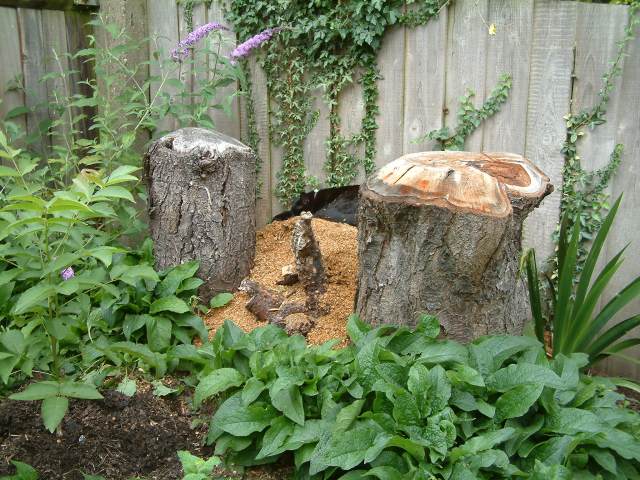| Main | Grubs in my compost | Stag beetle larvae |
Stag beetles in my back garden

Our stag beetle habitat: a heavily mulched wood-pile flanked by a couple of cherry tree stumps, plus Elvis, the next door neighbour's cat. Photo taken on August 6 2005 three months after the second cherry tree was cut down, the first was cut down in 2002.* There is also a productive buried bucket for beetles (BB4B) right next to the mulched walnut seedling, courtesy of a local grey squirrel, left bottom corner. Usually at the end of the summer I find lots of stag beetle remains in this area, and recently also their larvae both in the compost and leaf mould containers, which are just to the right of this photo.
* - There was a “larval incident” in January 2008, thus the cherry tree stumps have been successfuly colonized.
|
Ever since we moved to our present Colchester house in 1983, when our elder son was barely one year old, I have been fascinated by the stag beetles around us. As luck would have it we were now living in a stag beetle hot spot.
Not surprisingly a few years later, as our boys grew, I found myself regularly showing stag beetles at their primary school.
I remember one particular time when I had put a cardboard partition in a tray: stag beetles (Lucanus cervus) one side and lesser stag beetles (Dorcus parallelipipedus) the other, as I thought.
Well, by the time that I was ready to take them to school the beetles had climbed over and were happily mating!
From then on I was determined to follow, step by step, their life cycle and it has been a fascinating hands-on experience in my back garden where the larvae used to live in the leafmould pile. Since 1999 they have got a loggery made out of branches from an ancient flowering currant bush (a tall Ribes sp.) from a neighbour's garden, which had to come down to make room for a patio. Surprisingly it was full of larvae and I got those too. Recent photo shown on the top.
But I am not there yet: I have never seen the eggs (I have in 2003, see here) or a moulting larva. They moult several times, the last one inside the cocoon, but the exact timing of each larval instar is not known because it seems to depend a lot on the quality of their food.
However I have been learning all the time, mainly that around May to June when the larvae, get ready to pupate they become very vulnerable indeed and at this stage they must not be interfered with.
Of course, the same applies to the defenseless pupa. Which is resting inside a wonderful earth ball compacted with larval secretions well laced with protective anti bacterial and fungal substances. If this ball is broken then the pupa loses its protection and dies.
So far, as a result of my involvement with beetles and children (who sometimes have trouble understanding metamorphosis), I have designed a life cycle wheel while working as a volunteer for the former Countryside Services in Colchester during 1998 and then in May 2000, from home, launched this website.
In my experience most people, even the ones who already have made loggeries (piles of logs half buried in the soil) in their gardens, have no idea of how long their life cycle is and the understanding of it is, I think, crucial to the beetles' effective protection.
First written in 1999, last updated on January 3 2009.
| Main | Grubs in my compost | Stag beetle larvae |
